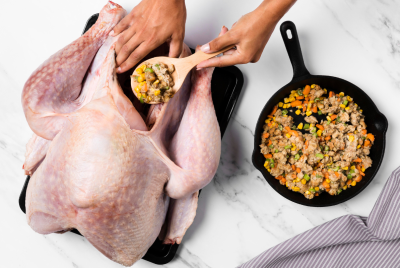UK food and drink sector expected to reach £315.2 billion by 2028
The UK food and drink sector is projected to reach £315.2 billion by 2028, a 19 per cent increase from 2023, according to IGD.

According to a new projection from the Institute of Grocery Distribution (IGD) that gives a combined perspective combining eating in and eating out, the overall UK food and drink sector is expected to be valued at £315.2 billion by 2028, up 19 per cent from 2023 (£265bn).
The new outlook, which combines IGD's UK retail channel and eating-out projections, presents a comprehensive picture of the challenges and possibilities facing the food and beverage industry over the next five years, including comparison and breakdown of both sectors.
The whole market's expected increase is mostly driven by inflation, which IGD expects will peak in March 2023. However, growth in real terms is declining across the board due to the impact of the cost of living problem on consumer spending, with the eating-out sector being the most impacted as consumers switch to eating at home to save money.
IGD's research further revealed that consumers are opting for private labels and inexpensive options in retail. As inflation falls and family disposable income rises, the market is expected to stabilise by 2025.
As customers are compelled to cut back on expenditure, IGD noted that there has been a shift back from eating out to eating in this year. Retail has seen a shift away from hypermarkets and supermarkets and towards discounters, convenience stores, and internet sales, as well as a shift towards cheaper products.
Foodservice, according to IGD's research, is witnessing a greater short-term decline than retail as consumers reduce their expenditure or leave the sector entirely. The result of lockdowns was a shift from eating out to eating in, in 2020, followed by a return to dining out in 2022.
However, retail has reclaimed part of the "share of stomach" in 2023 as customers shift from more routine and impulsive eating out situations to eating in, adopting meal deals and ready meals to meet the demand for simplicity and speed on a reduced budget.
By 2028, IGD stressed that the industry's real worth will be barely below pre-pandemic levels, demonstrating the long-term consequences of the pandemic and the cost-of-living issue on consumer spending appetite and behaviours outside the home.
According to IGD, the food and beverage retail industry will rise at a rate of +15.1 per cent this year, owing to strong inflation. With inflation removed from 2023, IGD added that the market will fall by 2 per cent in real terms as shoppers cut their purchases to save money.
Trading down to lower products, such as private label choices, will continue in 2024, with buyers shifting to discount outlets such as Aldi and Lidl. Multiples will compete through loyalty programmes, price matching, and own-label price discounts, the company stated.
Bryan Roberts, Global Insight Leader at IGD, commented on the UK food and drink retail outlook. He highlighted that the discounters have played an important role throughout the cost of living crisis as people continue to look for ways to save money on food, and this, along with their store opening programmes, is reflected in their projected growth over the next few years. Roberts stressed that it will be difficult for other channels to compete during this period, but as costs begin to level out and shoppers become more comfortable with discretionary spending over time, we will see more multi-channel use.
According to the Global Insights Leader at IGD, shoppers will keep a mixed buying repertory, favouring convenience and experience while adhering to some money-saving habits that will have become ingrained by this point. This opens up prospects for other channels, especially as the timing coincides with a slowdown in discounter expansion ambitions, he added.
Roberts further stated: "While shoppers continue to look for ways to save money, a variety of initiatives such as strong value messaging and loyalty schemes is set to continue in the short-term."
IGD forecasts that eating out is expected to expand by 4.1 per cent in 2024, owing mostly to price increases that lag below commodity inflation rates. This will be offset by a continued decline in visits and trade within the sector. Longer-term forecasts predict that hospitality volume growth will resume in early 2025, as real wage growth and consumer confidence recover.
Nicola Knight, a senior analyst, sector expert and insights manager at IGD, stated the challenges and prospects for eating out over the next five years. Knight said eating out will return in line with household income growth in the medium term, but consumers will expect great experiences and a high-quality offer. According to Knight, full service will be more expensive, dividing the market among treat occasions and everyday Quick Service Restaurants (QSR) missions.
In the short term, the senior analyst disclosed that consumers will use tactics to manage their spending in restaurants. She stated that they will choose fewer or smaller courses, eat at less expensive restaurants and hunt for deals and discounts. Restaurants will have to work hard, in the long run, to entice customers back, which will entail improving value and experience, competing for loyalty and pushing people to trade up on their meals and purchase more courses, she added.
Knights further said operators will continue to cut costs by using less expensive ingredients and simpler processes. Businesses that can effectively use loyalty scheme data to retain customers would gain in the long run, she said, allowing the sector to preserve its share of the overall eating-out market. Drive-thrus, gasoline station concessions and leisure areas will also be popular QSR destinations.
While the general market outlook is reasonably optimistic as the country emerges from the cost-of-living crisis, IGD pointed out that consumers will be harmed by a lag in price reductions in the food sector due to factors such as wages and commodity prices. IGD, therefore, encouraged businesses to consider how they may continue to assist consumers in saving money, even while the industry recovers.
© Copyright IBTimes 2025. All rights reserved.





















